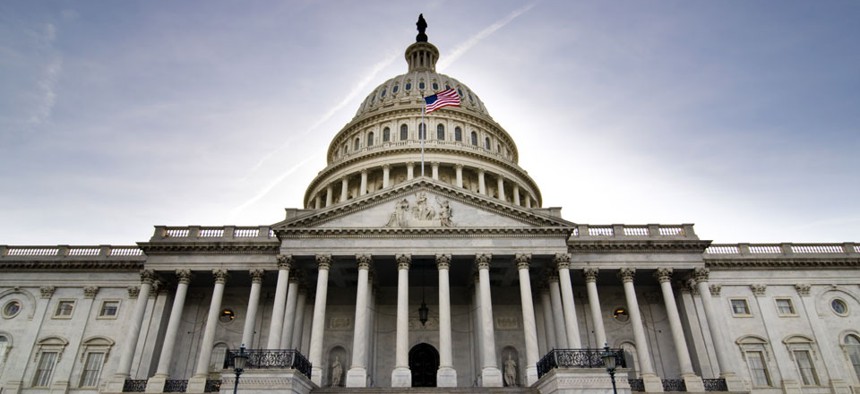
Ryan Rodrick Beiler/Shutterstock.com
With Fiscal Fights Looming, Can Simpson-Bowles Group Get Congress to Move?
Fix the Debt effort has the cash to make campaigns difficult for uncompromising members.
With its bipartisan branding, boldface names, and big money, the Campaign to Fix the Debt muscled its way into Washington power politics last summer. But as Congress preps for yet another fiscal showdown, Democrats and Republicans doubt the group has the swat to push either side far enough toward the center to secure its holy grail: a grand bargain that includes entitlement-spending reforms and new revenues that reduce the deficit.
Not even a $25 million war chest is enough to convince congressional insiders that the coalition has the juice to break the partisan impasse. By advocating for entitlement reforms, which Democrats dislike, and new revenues, which Republicans reject, the group may have only succeeded in convincing each party that they aren't pushing the other side hard enough.
"I don't think they advocate incredibly strongly or effectively," said a Senate Democratic aide. "For how much money they have, they should be more effective."
Another Democrat, a Senate leadership aide, put it this way, "They'd get farther if they would be willing to push Republicans on revenues as part of the debt discussion."
And then there's the Republican take: "For Fix the Debt to be successful they have to do a lot of work on the other side of the aisle," said a senior GOP Senate aide. "That's where Fix the Debt's challenges are going to be, on the left. Reform is hard."
The Senate Democratic aide, who is familiar with the group's workings, argued that the group's importance has lessened since the fiscal-cliff battles. As the country approached last year's deadline that would have raised taxes and triggered across-the-board spending cuts, lawmakers panicked. Fix the Debt, the aide said, swooped in and expertly played the role of bipartisan educators.
But this time around, the debates are familiar, as lawmakers discuss funding the government beyond Sept. 30 and raising the government's borrowing limit.
"People aren't really scared, certainly like they were leading up to the fiscal cliff," the aide said.
Not to mention that some Democrats view Fix the Debt warily because it's funded by big businesses including General Electric, which gave $1 million to its parent organization, and JP Morgan Chase, which gave the campaign $500,000. Some Democrats argue that the group tilts conservative.
Fix the Debt spokesman Jon Romano says the group is even better prepared for this fall's looming fiscal showdown than it was for last year's fiscal cliff. Since then, the group has increased its state network by 60 percent and is now active in 33 states and has 625 committee members, 120 former representatives and senators, and 2,500 small-business members.
"Anybody who thinks this campaign was going to go away after the inaction of the last year is just kidding themselves. We're more equipped now for this next phase than we were, frankly, during the fiscal cliff," Romano said. "Our message is going to be loud and clear: We need Congress and the president to put a debt deal in place."
The group plans to push Congress to reconsider the across-the-board spending cuts that went into place earlier this year, painting it as an issue that hurts everyday Americans.
"Fifty-seven thousand kids aren't going to have Head Start because Congress couldn't fix the debt," he said. "One hundred and thirty-six thousand families aren't going to have rental assistance because Congress couldn't fix the debt."
But perhaps more convincing than any rhetoric is the group's billfold. It has the resources to make a lot of noise but has yet to use them effectively. But that may be changing.
According to a source familiar with the campaign's strategy, Fix the Debt is considering using some of that cash to exert influence through campaign politics. "Twenty-five million dollars is a lot of money. Members don't want to go into their reeelection with another headache and there aren't many groups that have that kind of money."
Indeed, that cash buys a lot of organization. The group has sent 150,000 letters to lawmakers, placed 150 state op-eds, and held a July fly-in where 55 people from 19 states held 73 meetings that generated 40 media mentions in 19 markets. And the group plans to do print, TV, and online advertising in targeted districts, Romano said.
But Romano acknowledged there is only so much outside groups can do to push lawmakers toward a deal.
"There's not going to be a deal because of pressure from outside groups like this. There's going to be a deal because they want to lead on this," Romano said. "We're going to put as much pressure as possible on them to get a deal done."
(Image via Ryan Rodrick Beiler/Shutterstock.com)






